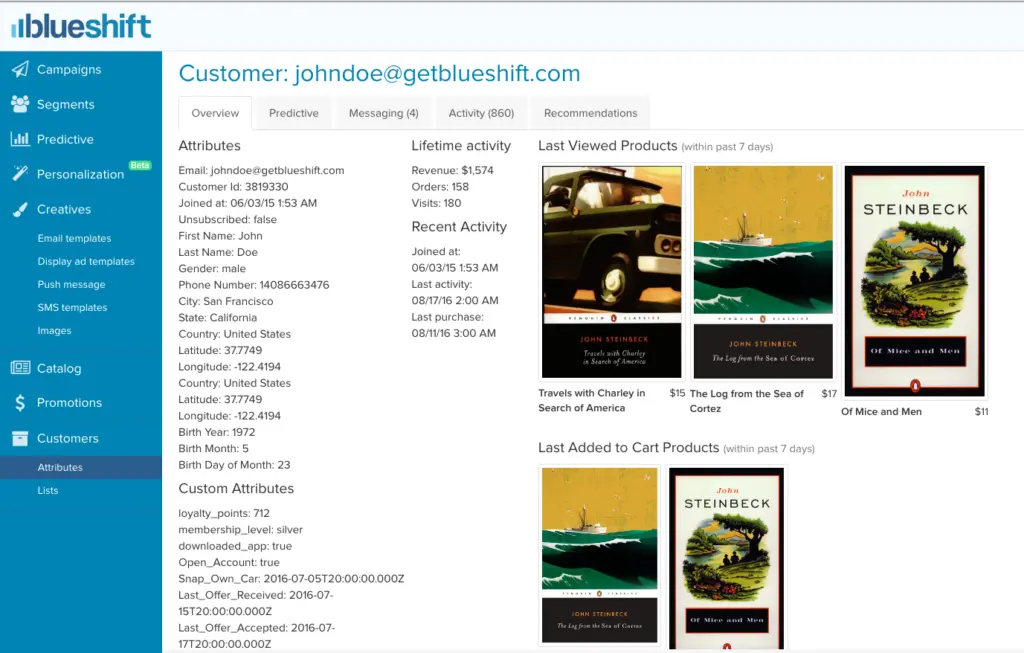Artificial intelligence may be complex, but its job is actually to make life simpler for marketers. After all, marketing has become a little more complicated, thanks to the sheer number of online channels where consumers spend their time (and dollars).
 That’s where a platform like Blueshift comes in. The company’s solution uses patented artificial intelligence to automate personalization across channels, so business are able to market one-to-one—at scale.
That’s where a platform like Blueshift comes in. The company’s solution uses patented artificial intelligence to automate personalization across channels, so business are able to market one-to-one—at scale.
We spoke with Blueshift cofounder and CEO Vijay Chittoor (@vijaycs42) to learn how the solution uses AI to supercharge your marketing.
1. In a single sentence or statement, describe Blueshift.
Blueshift is a next generation cross-channel marketing platform for engaging today’s connected consumer, built with autonomous AI.
2. How does Blueshift use artificial intelligence (i.e. machine learning, natural language generation, natural language processing, deep learning, etc.)?
Blueshift uses patented technology for delivering AI to marketers in the form of self-driving marketing campaigns. The technology automates personalization along the entire customer journey and executes continuously to determine the right marketing action for each customer.
With Blueshift, for the first time, marketers can use the full power of AI without support from a data science or an engineering team. The highlights of the AI include:
- Built on a unified customer view, leveraging historical and real-time customer data: The system continuously listens to new data about customers (e.g. website/app/PoS interactions) and updates the customer data index to reflect all the latest customer interactions. This 360-degree view of the customer, or the “customer data index”, forms the basis for the AI.
- Adapts to your data: The system is flexible to work with the data semantics used by your business, instead of imposing a rigid schema. This enables us to rapidly onboard different types of customers, each having different complexities in their data.
- Puts the power of AI in the hands of marketers: While the system does all the heavy lifting to run different types of AI algorithms, we also expose an intuitive user interface for non-technical marketers to understand the models and adapt it to their use cases.
3. What do you see as the limitations of artificial intelligence as it exists today?
On the one hand, we want AI to be accurate, and on the other, we want it to be explainable or interpretable. AI as it exists today poses some trade offs between interpretability and accuracy.
For instance, techniques like deep learning don’t lend themselves well to the models being explainable. In domains like marketing, where the human creative aspects need to work together with data-driven targeting and optimization, it becomes very important to ensure that the models are explainable.
4. What do you see as the future potential of artificial intelligence in marketing?
Just like AI technology in cars is moving from driver-assisted to self-driving cars, AI in marketing will start becoming pivotal in orchestrating the entire customer journey. For the first time, marketers will be able to deliver true storytelling at scale, personalized for every customer across every channel, with the help of AI.
5. What makes Blueshift different than competing or traditional solutions?
Unlike competing cross-channel marketing solutions offered by legacy marketing clouds that were built in the era of list-based marketing on a single channel, Blueshift is built for today’s challenges of activating complex customer data across multiple channels. Our AI-first approach helps with this on two fronts:
- Ingest and activate all customer data in real-time: A majority of all marketers are using less than half of their customer data in their marketing campaigns. With today’s data complexity, it is impossible for marketers to activate their data if they continue to rely on manual or human-intensive techniques for segmentation and personalization. By leveraging Blueshift’s AI, marketing teams of any size can activate all of their customer data in real-time.
- Customer-centric, instead of channel-centric: Unlike other solutions that are channel centric, Blueshift takes a holistic view of the customer journey across channels and lifecycle stages. With this approach, Blueshift’s AI helps marketers deliver a consistent and delightful customer experience. Blueshift supports both “push” channels (e.g. email, SMS, mobile notifications, direct mail), as well as “live” channels (e.g. website and in-app content recommendations). Similarly, Blueshift also supports both “owned” channels as well as “paid” channels that involve ad spend.
6. Who are your prototype customers in terms of company size and industries?
Blueshift’s customers include consumer brands and services of all sizes. The industries span a wide range of B2C categories, including personal finance (e.g. LendingTree, Clearscore), media and publishing (e.g. BBC, IAC), e-learning (e.g. Udacity, Skillshare), e-commerce and marketplaces (e.g. Tradera, Artifact Uprising), and local and travel (e.g. Zumper, Suiteness).
7. What are the primary use cases of Blueshift for marketers?
Blueshift’s use cases map to all stages of executing and optimizing a marketing campaign: “who” to target; “what” content, product or offer to present each user; “when” is the right time to engage; and “where," or which channel, to reach the customer on.
- Predictive Audience Targeting (“Who”): Blueshift’s AI uncovers customer propensities towards various actions, e.g. which customers are likely to churn in the next month or which customers are most likely to respond to a promotion. Using multiple data points, the models built by the AI can develop micro-segments with much higher response rates than you could obtain by manually segmenting your customers.
- Predictive Content/Offer/Product Recommendations (“What”): Netflix and Amazon have shown us the power of recommendations around product and content, to drive a superior user experience and to keep customers coming back. With Blueshift’s AI, you can now apply the same idea to all types of brands, ranging from travel and hospitality to consumer finance, media, e-commerce and more.
- Predictive Campaign or Journey Optimization (“When” and “Where”): Blueshift’s AI can understand the right time, the right channel, and the right creative to engage each customer.
8. Any other thoughts on AI in marketing, or advice for marketers who are just starting to explore the possibilities of AI?
Artificial intelligence is only as smart as the data it is receiving. Marketers will find that the biggest gains you can make in driving results from AI will come from using more of their data.
Using the analogy of cars, everyone can see that self-driving cars are finally becoming a reality only because of a massive amount of map and street view data that helps the AI anticipate every possible scenario. Similarly, in the world of marketing, it will be very important to tap into all sources of customer data. As they embark on their AI journey, marketers must prioritize activating their customer data.
Paul Roetzer
Paul Roetzer is founder and CEO of Marketing AI Institute. He is the author of Marketing Artificial Intelligence (Matt Holt Books, 2022) The Marketing Performance Blueprint (Wiley, 2014) and The Marketing Agency Blueprint (Wiley, 2012); and creator of the Marketing AI Conference (MAICON).


